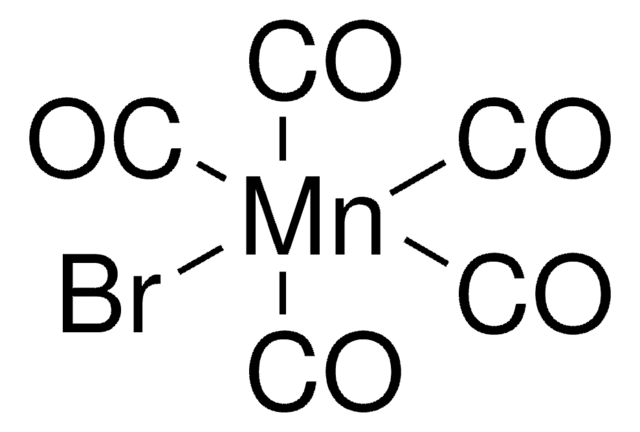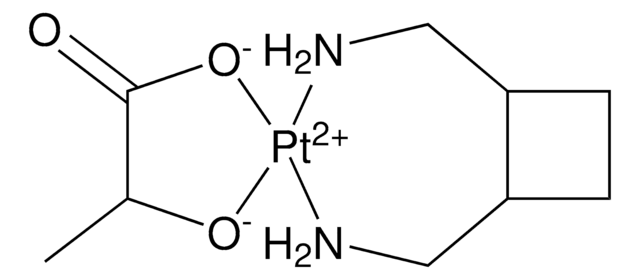SML0496
CORM-3
Synonym(s):
Carbon monoxide releasing molecule 3, Tricarbonylchloro(glycinato)ruthenium (II)
Sign Into View Organizational & Contract Pricing
All Photos(1)
About This Item
Empirical Formula (Hill Notation):
C5H4ClNO5Ru
CAS Number:
Molecular Weight:
294.61
UNSPSC Code:
12352200
NACRES:
NA.77
Recommended Products
form
powder
Quality Level
storage condition
desiccated
color
white to beige
solubility
H2O: 20 mg/mL, clear
shipped in
wet ice
storage temp.
−20°C
Application
CORM-3 (carbon monoxide (CO) releasing molecule-3) has been used to study its effect on NLRP3 (leucine-rich-repeat-containing receptor, pyrin-domain-containing 3) inflammasome activation via glycolysis in macrophages and also on hyperglycemia-induced IL-1β (interleukin-1 β) production. It has also been used to study its protective function against H2O2-induced apoptosis using primary rabbit lens epithelial cells.
Biochem/physiol Actions
CO possesses anti apoptotic function and offers protection against oxidative damage, promoting endothelial healing. CORM-3 is known to have therapeutic effects in transplantation, myocardial infarction and rheumatoid arthritis.
CORM-3 is a water-soluble carbon monoxide (CO) releasing molecule that can be used to study the effects of CO on cellular systems. Carbon monoxide (CO), produced during the degradation of heme by the enzyme heme oxygenase, has recently been found to be an important gaseous signaling mediator in mammalian cells CORM-3 has been shown to have anti-inflammatory and cardioprotective activity.
Storage Class Code
11 - Combustible Solids
WGK
WGK 3
Flash Point(F)
Not applicable
Flash Point(C)
Not applicable
Certificates of Analysis (COA)
Search for Certificates of Analysis (COA) by entering the products Lot/Batch Number. Lot and Batch Numbers can be found on a product’s label following the words ‘Lot’ or ‘Batch’.
Already Own This Product?
Find documentation for the products that you have recently purchased in the Document Library.
CORM-3 Reactivity toward Proteins: The Crystal Structure of a Ru (II) Dicarbonyl? Lysozyme Complex.
Santos-Silva T, et al.
Journal of the American Chemical Society, 133(5), 1192-1195 (2011)
Carbon monoxide (CO) inhibits hydrogen peroxide (H2O2)?induced oxidative stress and the activation of NF-?B signaling in lens epithelial cells.
Huang Y, et al.
Experimental Eye Research, 166, 29-39 (2018)
Carbon monoxide regulates glycolysis-dependent NLRP3 inflammasome activation in macrophages.
young S H, et al.
Biochemical and Biophysical Research Communications, 493(2), 957-963 (2017)
Ricardo Coletti et al.
Journal of neuroendocrinology, 31(2), e12686-e12686 (2019-01-12)
Nitric oxide (NO) negatively modulates the secretion of vasopressin (AVP), oxytocin (OT) and atrial natriuretic peptide (ANP) induced by the increase in extracellular osmolality, whereas carbon monoxide (CO) and hydrogen sulphide (H2 S) act to potentiate it; however, little information
Eric K Patterson et al.
Experimental biology and medicine (Maywood, N.J.), 246(21), 2338-2345 (2021-07-23)
In sepsis-induced inflammation, polymorphonuclear neutrophils (PMNs) contribute to vascular dysfunction. The serine proteases proteinase 3 (PR3) and human leukocyte elastase (HLE) are abundant in PMNs and are released upon degranulation. While HLE's role in inflammation-induced endothelial dysfunction is well studied
Articles
DISCOVER Bioactive Small Molecules for Nitric Oxide & Cell Stress Research
Our team of scientists has experience in all areas of research including Life Science, Material Science, Chemical Synthesis, Chromatography, Analytical and many others.
Contact Technical Service








